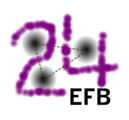Speaker
Description
Neutrino scattering on nuclei has been investigated for several decades. It played an important role in establishing fundamentals of the theory of weak interactions and electroweak unification. Later it became a tool to study the much more subtle properties of neutrinos, such as masses and oscillations.
Most of the calculations for neutrino scattering on light nuclei were performed in coordinate space, see important Refs. (1-4). In a recent paper (5) we presented momentum-space based results for several (anti)neutrino induced reactions on light nuclei: $$\nu(\bar{\nu}) +{^2}\mathrm{H} \rightarrow \nu(\bar{\nu})+p+n \, ,\\ \bar{\nu}+{^2}\mathrm{H}\rightarrow e^++n+n \, ,\\ \nu (\bar{\nu})+{^3}\mathrm{He}\rightarrow \nu (\bar{\nu})+p+{^2}\mathrm{H} \, ,\\ \nu (\bar{\nu})+{^3}\mathrm{He}\rightarrow \nu (\bar{\nu})+p+p+n \, ,\\ \nu (\bar{\nu})+{^3}\mathrm{H}\rightarrow \nu (\bar{\nu})+p+{^2}\mathrm{H} \, ,\\ \nu (\bar{\nu})+{^3}\mathrm{H}\rightarrow \nu (\bar{\nu})+n+n+p \,, \\ \nu+{^3}\mathrm{He} \rightarrow e^++n+{^2}\mathrm{H} \, ,\\ \nu+{^3}\mathrm{He} \rightarrow e^++n+n+p \,, \\ \nu+{^3}\mathrm{H} \rightarrow e^++n+n+n \, .$$ We restricted ourselves to neutrino energies up to 300 MeV and pointed out to problems arising from merging relativistic kinematics with nonrelativistic dynamics. For the inelastic reactions on the deuteron we calculated directly the total cross sections $\sigma_{tot} (E)$ at many incoming neutrino energies. The essential building block for the total cross section at a given (anti)neutrino energy $E$ is the threefold differential cross section $d^3\sigma/d\Omega^{\, \prime} \; d E^{\, \prime}$, which depends on $E$, on the (anti)neutrino scattering angle $\theta^{\, \prime}$ and on its final energy $E^{\, \prime}$. Namely, the total cross section is most easily calculated as $$ \sigma_{tot} (E) = \int d \Omega^{\, \prime} \int d E^{\, \prime} \frac{d^3\sigma}{d\Omega^{\, \prime} \; d E^{\, \prime}} \, = \, 2 \pi \int d \theta^{\, \prime} \sin \theta^{\, \prime} \int d E^{\, \prime} \frac{d^3\sigma}{d\Omega^{\, \prime} \; d E^{\, \prime}} \, . $$ The cross section $d^3\sigma/d\Omega^{\, \prime} \; d E^{\, \prime}$ can be expressed in terms of the so-called response functions $R_{jk}$ (5), which depend on two parameters only: on the internal energy of the nuclear system $E_{CM}$ and on the magnitude of the three-momentum transfer $Q$: $$ \frac{d^3\sigma}{d\Omega^{\, \prime} \; d E^{\, \prime}} \, = \, \sum\limits_{jk} v_{jk} \left(E, \theta^{\, \prime} , E^{\, \prime} \right) \, R_{jk} \left( E_{CM} , Q \right) \, . $$ Since the $v_{jk}$ functions, stemming from the lepton matrix element, are analytically known, it is thus much more efficient to calculate just the response functions on a sufficiently dense two dimensional grid in the $\left( E_{CM} , Q \right) $ plane and use interpolations to obtain these values of the response functions which are needed to compute $\sigma_{tot} (E) $ at a required energy $E$. Note also that in the case of the neutral current driven reactions, exactly the same response functions can be used to obtain cross sections with neutrinos and antineutrinos. This approach has been already successfully tested for the (anti)neutrino reactions on the deuteron and one example of the response function for the $\nu(\bar{\nu}) +{^2}\mathrm{H} \rightarrow \nu(\bar{\nu})+p+n$ reaction is shown in Fig. 1. The corresponding work for several reactions with the three-nucleon systems is in progress and will be reported at the conference. As in Ref. (5), also in the present calculations the single nucleon current from Ref. (6) and the AV18 two-nucleon potential (7) is employed. !Fig.1 [The $R_{00}$ response function (see Ref. (1) for the definition and more details) for the neutral-current driven process $\nu(\bar{\nu}) +{^2}\mathrm{H} \rightarrow \nu(\bar{\nu})+p+n$]1
References
(1) S. Nakamura, T. Sato, V. Gudkov, and K. Kubodera, Phys. Rev. C 63, 034617 (2001);
Erratum: [Phys. Rev. C 73, 049904 (2006)].
(2) S. Nakamura et al., Nucl. Phys. A 707, 561 (2002);
http://www-nuclth.phys.sci.osaka-u.ac.jp/top/Netal/total/index.html.
(3) G. Shen, L. E. Marcucci, J. Carlson, S. Gandolfi, and R. Schiavilla, Phys. Rev. C 86, 035503 (2012).
(4) A. Baroni and R. Schiavilla, Phys. Rev. C 96, 014002 (2017).
(5) J. Golak et al., Phys. Rev. C 98, 015501 (2018).
(6) J. Golak et al., Phys. Rev. C 90, 024001 (2014).
(7) R. B. Wiringa, V. G. J. Stoks, and R. Schiavilla, Phys. Rev. C 51, 38 (1995).




